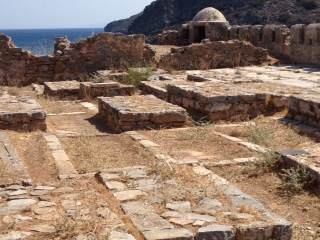Spinalonga: The island of Lepers
A leper colony in our times: hard to imagine, but true. The island of Spinalonga off the coast of Crete, Greece was one of the last leper colonies in Europe. In operation from 1903 to 1957 it remains open for visitors to this day and can be accessed via ferry from various points on the east coast of Crete.
It is estimated that approximately 1,500 lepers, originating from all over Greece, were assigned to Spinalonga at any one time during its active operation. The common belief was that this bacterial infection was contagious and that individuals with this skin condition needed to be shunned from society. Today, we know that leprosy is not contagious and can be cured in a matter of days.
A visit to Spinalonga allows one to witness first-hand just how barbaric our thought process was in recent times (some leper colonies even issued their own currency in the belief that allowing lepers to handle money could spread the disease). On Spinalonga lepers were not allowed to leave the island and were kept away from their friends and family on the mainland.
The main entrance to Spinalonga was through a tunnel known as ‘ Dante ‘s Gate’. Upon arrival, patients (as they were called) did not know what was going to happen to them. However, once on the island they received food, water and medical attention. The leper colony had a physician-director, nursing personnel, a caretaker, a financial department, and a priest. Patients lived independently in their own space, and were responsible for earning their own livelihood that was supplemented by an allowance from the state.
To the surprise of many, the lepers became self-sufficient. They organized their space, cultivated the land, had relationships, married from amongst the leper community and had children. The limitations imposed on them by the state and the hardships connected with their disease did not weaken their desire to conduct a fulfilling and fruitful life.
After the leper colony closed at Spinalonga in 1957 it remained largely desolate and uninhabited. The last inhabitant, a priest, left the island in 1962. He stayed as long as he did in order to maintain the religious tradition of the Greek Orthodox Church, in which a buried person has to be commemorated after their death at intervals of 40 days; 6 months; 1 year; 3 years; and 5 years. After the abandonment of the colony the island became stigmatized as a place for suffering.

When visiting Spinalonga it is also interesting to see the evolution of this island dating back centuries. The island was considered to be in a strategic location, adjacent to precious salt reserves of the mainland. So in order to defend the island of Crete from the Turks, in the late 16 th century, the Venetians built one of the most important defensive sea fortresses in the Mediterranean.
Following a siege in 1715 the island was surrendered to the Turks and was settled by the Muslims who operated a trading center. In 1898 Spinalonga became liberated from the Turks, who initially remained on the island and finally left when it became inhabited by the lepers in 1903.
Many leper colonies exist even today, primarily in areas where treatment for leprosy is not universally available, or where traditional attitudes regarding leprosy as ‘unclean‘ have remained. Such countries include India (where there are still more than 1,000 leper colonies), China , Romania , Egypt , Nepal , Somalia , Liberia , Vietnam , and Japan .
A visit to Spinalonga, Crete is a valuable experience from both a historical and cultural perspective.
Donna Salle is a freelance travel writer and can be reached at TravelsWithHeart@gmail.com.
